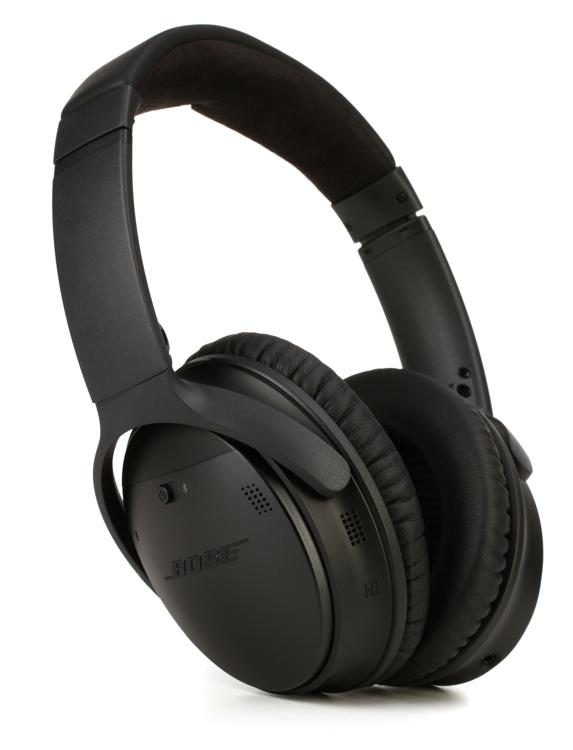If you are a commuter, or simply someone who travels frequently, your set of headphones would probably be your best friend. You certainly wouldn’t want to waste this time doing anything, so you either start listening to music, lectures, a podcast or try and get some work done on your trip.
Still, when you’re surrounded by such an overwhelming number of different sounds and noises, it’s practically impossible to get anything done. That’s where our comparison between noise isolating vs noise-canceling headphones comes into play. We hope that you can make an informed, wise decision for your next investment.
Contents
Noise Isolating vs Noise Canceling Headphones: Special Components
Noise isolating headphones need nothing but the body of the headphones themselves to work.
On the other hand, noise-canceling headphones require three extra components, which are a digital signal processor, a clear microphone, and a large battery. The microphone and battery will most probably be included anyway, but for noise cancelation, they’ll have to be of excellent quality.
Mechanism
So, how does each one of them work, and why does one involve extra components, while the other doesn’t?
Firstly let’s speak about noise-canceling since it’s the more complicated one. You’re on an airplane and you have your headphones on. They’re catching on all of the exterior noises, such as that of the plane’s engine. That’s when noise cancelations hit; the microphone picks that up then sends it to the digital signal processor.
The digital signal processor then analyzes the sound waves knowing the frequency and goes on to create the exact opposite frequency and emits it. When the exterior frequency and the newly created one meet inside the headphones, they cancel each other out so that you are left with your music without any disturbances.
On the other side of the spectrum, noise isolation doesn’t require anything other than the build of the headphones themselves. If you’re talking about large over-ear headphones, then it’s the foam padding of your ear cups that will do the trick.
Yet, if we’re talking about earbuds, then it’s either the robber nozzle or the plastic build of the earbud that will block exterior noises from entering through creating a seal with the walls of your ear. The better the seal, the less you’ll hear.
Price
As we’ve mentioned before, noise-canceling headphones come with extra components. That’s why their price is much higher than the noise-isolating ones. Actually, today, you’ll find products on the market, like Bose QuietComfort II 35, that come with three different levels of active noise cancelation and an incredible battery, which explains the fattened-up price-tag.

Find Bose QuietComfort 35 II featured in:
- Headphones For Transcription
- Headphones for Mowing
- Headphones for Glasses
- Headphones for teens
- Headphones for Movies
Moreover, don’t forget that headphones with ANC will require a larger battery as ANC always manages to do a pretty great job of draining your battery quite fast.
On the contrary, noise isolating headphones are quite affordable as they can be wired or wireless. So, the battery thing is all up to you, making them incredibly affordable.
Effectiveness
How much noise each one of these technologies is capable of removing is an incredibly important question. You see, each one of them works better with a particular type of sound.
Although active noise cancelation can remove as much as 80 dB of unwanted noise, they’ve been known to work a lot better with continuous ambient noises such as airplane engines, traffic, or anything that just has a streak. They don’t do well with sudden noises such as talking.
Noise isolation can remove up to 25-30 dB of noise isolation. Still, they work a lot better on sudden noises such as people talking or whispering.
Power Source
Noise cancellation definitely can’t work without a power source, which is one of the main reasons why noise-canceling headphones sport such enormous price tags. The power source needs to be capable of not just powering the headphones, but also supporting the noise cancelation feature for extended periods.
Noise-isolating headphones, on the other side, require no power source. Therefore, they don’t affect the price or the power limits of headphones whatsoever.
Best With?
Disclaimer: this is unquestionably a matter of personal preference. You can always try one set of headphones and find it to be incredibly comfortable, while your friend will say that he wasn’t able to tolerate it for more than a few minutes.
Therefore, the main advice is to always try out the headphones before purchasing them, and see where you’re more comfortable through trying to explore all different types of headphones in order to find your preference.
Noise cancellation works better on bigger headphones such as over-ear closed-back ones for several reasons. Firstly, this size allows for accommodating a bigger battery that will carry you through significant time.
Secondly, an over-ear, closed-back headphone set will provide you with a significant level of noise isolation so that you will have both technologies in one device. You’ll be able to block both continuous and sudden noises.
Nevertheless, if you wish to go with headphones that are noise isolating only, you might want to go with earbuds as they’re designed with rubber nozzles that manage to fit into the contours of your ear, making a tight seal with the ear canal walls. The mentioned seal provides the optimum level of noise isolation.
Sound Quality
Do noise isolation or noise cancelation have any effect on sound quality? The answer here is yes to noise cancelation, and no to noise isolation.
Speaking of the first, noise cancellation might end up creating a sort of background humming noise that will always be there when ANC is turned on, and you’ll hear it mostly if you have nothing on playing. It can be quite annoying as it never goes away.
Noise isolation is more of a physical process, so there’s no harm done here whatsoever.
Recommendations
If we’re going to recommend noise-canceling headphones, then you could definitely go with the Bose QuietComfort II 35, as they come with a plethora of amazing features that will take your listening experience a whole other level.
Not to mention, they feature three levels of world-class active noise cancelation, an over-ear, closed-back design with padded ear cups for noise isolation, and 20 hours of playtime.
The COWIN E7 is also a great set of headphones that can offer you up to 30 hours of playtime per charge and 49 ft of transmission range.

As for noise isolating earbuds, you can definitely go with another product from Bose, which is also from the QuietComfort line. However, these are the 20 model. The Shure SE215 earbuds are also a great pair that will serve you well.

Final Words
Hopefully, we’ve managed to cover all the points where there are differences between noise isolating vs. noise-canceling headphones. These two technologies are such an asset to any set of headphones, and if you don’t want to pay too much money for ANC, then sound isolation is a great option for anyone.
By no way is one of these options better than the other, it’s simply a matter of your own needs and wants in relation to your budget. If you plan on buying headphones that will offer you ANC for a lot of money, you must know that turning on this feature quite often will actually benefit you and make your experience much finer so that you don’t waste your money.
Lastly, noise isolation can sometimes be advertised as passive noise cancellation as opposed to active noise cancellation, don’t let that confuse you.
